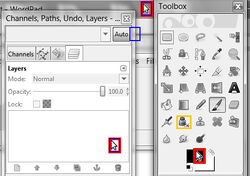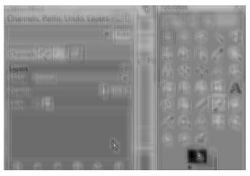Example Template Matching
Template matching finds all the points inside an image which match a template. A template is simply a smaller image. Typically template matching is only used in highly controlled environments and doesn't work to well in natural scenes. A template matching algorithm works by computing a fit score for each pixel in the image and then looking for local maximums.
The example below is intended to demonstrate the strengths and weaknesses of template matching. For each template the number of matches returned needs to be specified. If the number of matches is known then the results are good in this example, but if too many are requested the some of the results are noise. The intensity image is shown for a match. Notice how ambiguous the results are.
Example Code:
Concepts:
- Template Matching
Example Code
/**
* Example of how to find objects inside an image using template matching. Template matching works
* well when there is little noise in the image and the object's appearance is known and static.
*
* @author Peter Abeles
*/
public class ExampleTemplateMatching {
/**
* Demonstrates how to search for matches of a template inside an image
*
* @param image Image being searched
* @param template Template being looked for
* @param expectedMatches Number of expected matches it hopes to find
* @return List of match location and scores
*/
private static List<Match> findMatches(ImageFloat32 image, ImageFloat32 template,
int expectedMatches) {
// create template matcher.
TemplateMatching<ImageFloat32> matcher =
FactoryTemplateMatching.createMatcher(TemplateScoreType.SUM_DIFF_SQ, ImageFloat32.class);
// Find the points which match the template the best
matcher.setTemplate(template, expectedMatches);
matcher.process(image);
return matcher.getResults().toList();
}
/**
* Computes the template match intensity image and displays the results. Brighter intensity indicates
* a better match to the template.
*/
public static void showMatchIntensity(ImageFloat32 image, ImageFloat32 template) {
// create algorithm for computing intensity image
TemplateMatchingIntensity<ImageFloat32> matchIntensity =
FactoryTemplateMatching.createIntensity(TemplateScoreType.SUM_DIFF_SQ, ImageFloat32.class);
// apply the template to the image
matchIntensity.process(image, template);
// get the results
ImageFloat32 intensity = matchIntensity.getIntensity();
// adjust the intensity image so that white indicates a good match and black a poor match
// the scale is kept linear to highlight how ambiguous the solution is
float min = ImageStatistics.min(intensity);
float max = ImageStatistics.max(intensity);
float range = max - min;
PixelMath.plus(intensity, -min, intensity);
PixelMath.divide(intensity, range, intensity);
PixelMath.multiply(intensity, 255.0f, intensity);
BufferedImage output = new BufferedImage(image.width, image.height, BufferedImage.TYPE_INT_BGR);
VisualizeImageData.grayMagnitude(intensity, output, -1);
ShowImages.showWindow(output, "Match Intensity");
}
public static void main(String args[]) {
// Load image and templates
String directory = "../data/applet/template/";
ImageFloat32 image = UtilImageIO.loadImage(directory + "desktop.png", ImageFloat32.class);
ImageFloat32 templateX = UtilImageIO.loadImage(directory + "x.png", ImageFloat32.class);
ImageFloat32 templatePaint = UtilImageIO.loadImage(directory + "paint.png", ImageFloat32.class);
ImageFloat32 templateBrowser = UtilImageIO.loadImage(directory + "browser.png", ImageFloat32.class);
// create output image to show results
BufferedImage output = new BufferedImage(image.width, image.height, BufferedImage.TYPE_INT_BGR);
ConvertBufferedImage.convertTo(image, output);
Graphics2D g2 = output.createGraphics();
// Searches for a small 'x' that indicates where a window can be closed
// Only two such objects are in the image so at best there will be one false positive
g2.setColor(Color.RED);
drawRectangles(g2, image, templateX, 3);
// show match intensity image for this template
showMatchIntensity(image, templateX);
// Now it searches for a specific icon for which there is only one match
g2.setColor(Color.BLUE);
drawRectangles(g2, image, templatePaint, 1);
// Look for the Google Chrome browser icon. There is no match for this icon..
g2.setColor(Color.ORANGE);
drawRectangles(g2, image, templateBrowser, 1);
// False positives can some times be pruned using the error score. In photographs taken
// in the real world template matching tends to perform very poorly
ShowImages.showWindow(output, "Found Matches");
}
/**
* Helper function will is finds matches and displays the results as colored rectangles
*/
private static void drawRectangles(Graphics2D g2,
ImageFloat32 image, ImageFloat32 template,
int expectedMatches) {
List<Match> found = findMatches(image, template, expectedMatches);
int r = 2;
int w = template.width + 2 * r;
int h = template.height + 2 * r;
g2.setStroke(new BasicStroke(3));
for (Match m : found) {
// the return point is the template's top left corner
int x0 = m.x - r;
int y0 = m.y - r;
int x1 = x0 + w;
int y1 = y0 + h;
g2.drawLine(x0, y0, x1, y0);
g2.drawLine(x1, y0, x1, y1);
g2.drawLine(x1, y1, x0, y1);
g2.drawLine(x0, y1, x0, y0);
}
}
}

